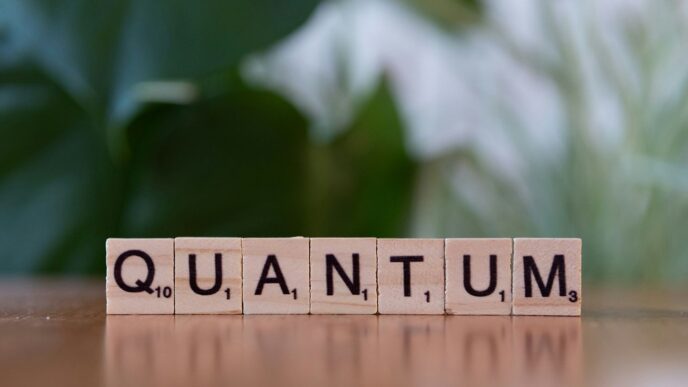So, China’s got a new quantum chip out, called Zuchongzhi 3. Apparently, it’s a pretty big deal. We’re talking about a china quantum computing chip zuchongzhi 3 that’s supposed to be way faster than anything else out there, even supercomputers. It’s got a lot more qubits than the last one, which is supposed to make it do more complex stuff. This whole quantum computing thing is kind of mind-bending, but it seems like China is really pushing the boundaries with this new chip.
Key Takeaways
- The Zuchongzhi-3, a new china quantum computing chip zuchongzhi 3, has been released by Chinese researchers.
- This chip boasts a high number of qubits and connections, improving on its previous version.
- It has shown incredible speed, reportedly outperforming even the most powerful supercomputers by a huge margin.
- The development highlights China’s ongoing progress and leadership in the quantum technology field.
- Zuchongzhi-3’s advancements in areas like coherence time and gate accuracy are important steps for future quantum computers.
Zuchongzhi 3: A New Era in Quantum Computing
It feels like just yesterday we were talking about the last big leap in quantum computing, and now, here we are again. China’s latest quantum processor, Zuchongzhi 3, has arrived, and it’s making some serious waves. This isn’t just a small upgrade; it’s a whole new ballgame for what we thought was possible with quantum machines.
Unprecedented Qubit Count and Connectivity
So, what’s the big deal? For starters, Zuchongzhi 3 is packing a serious punch with its 105 qubits. That’s a lot more than its predecessor, Zuchongzhi 2, which had 66. More qubits mean more processing power, plain and simple. But it’s not just about the number of qubits; it’s also about how they talk to each other. Zuchongzhi 3 has 182 couplers, which are like the communication lines between qubits. This improved connectivity is a big deal for making complex calculations work smoothly.
Record-Breaking Computational Speed Achieved
This is where things get really wild. Researchers ran a specific quantum circuit sampling task with Zuchongzhi 3, and the results were mind-blowing. The processor completed the task an estimated 10¹⁵ times faster than the most powerful supercomputers out there. To put that in perspective, it’s like comparing a bicycle to a rocket ship. This kind of speed is what scientists have been aiming for, and it really pushes the idea of ‘quantum advantage’ into new territory.
China’s Leadership in Quantum Technology
With Zuchongzhi 3, China is really showing its strength in the quantum race. This isn’t the first time they’ve put out a top-tier quantum processor, but this latest one really solidifies their position. It shows a consistent effort and a deep investment in pushing the boundaries of quantum technology. It’s clear they’re not just participating; they’re leading the charge in developing these advanced machines.
Quantum Supremacy Redefined

This is where things get really interesting. We’re talking about a point where quantum computers don’t just do cool tricks, they actually leave our best supercomputers in the dust. Zuchongzhi 3 is making a serious claim to this title. It’s not just a little bit faster; it’s operating at speeds that are hard to even wrap your head around compared to what we have now.
Outperforming Advanced Supercomputers
So, how much faster are we talking? Well, for a specific kind of complex calculation, Zuchongzhi 3 is reportedly 10¹⁵ times faster than the most powerful supercomputers out there. That’s a 1 followed by 15 zeros. To put it another way, it completed a task that would take today’s top supercomputers an impossibly long time in just a fraction of a second. This isn’t just an incremental improvement; it’s a massive leap.
Comparison with Previous Quantum Milestones
Remember when Google announced their Sycamore processor back in 2019? That was a big deal, completing a task in about 200 seconds that would have taken a supercomputer 10,000 years. But the game moves fast. Later, researchers showed that with a lot of effort and advanced classical computing, that same task could be done in seconds. Now, Zuchongzhi 3 is showing results that dwarf those earlier achievements. It’s a clear sign that quantum hardware is progressing at an incredible pace.
The Significance of Quantum Advantage
What does this all mean? It means we’re entering an era of ‘quantum advantage.’ This is when a quantum computer can solve a problem that’s practically impossible for any classical computer, no matter how powerful. Zuchongzhi 3’s performance on an 83-qubit random circuit sampling task, outperforming supercomputers by 15 orders of magnitude, is a strong indicator that we’ve reached this point for certain types of problems. This isn’t just about bragging rights; it’s about opening doors to solving scientific and industrial challenges that were previously out of reach.
Enhanced Performance Metrics
So, Zuchongzhi 3 isn’t just about having more qubits; it’s about making those qubits work better and longer. This is where things get really interesting.
Extended Coherence Times for Complex Computations
One of the biggest headaches in quantum computing is something called ‘coherence time.’ Basically, it’s how long a qubit can hold its quantum state before it gets messed up by its surroundings. Zuchongzhi 3 has managed to extend this significantly, reaching about 72 microseconds. This might not sound like much to us, but in the quantum world, it’s a big deal. It means the processor can handle more steps in a calculation before errors creep in, allowing for more intricate problems to be tackled. Think of it like having a longer attention span for really tough math problems.
High Fidelity in Quantum Gates and Readout
Beyond just staying coherent, the individual operations, or ‘gates,’ that manipulate qubits need to be super accurate. Zuchongzhi 3 boasts a single-qubit gate fidelity of 99.90% and a two-qubit gate fidelity of 99.62%. That’s really precise. Plus, reading out the final answer from the qubits is also important, and its readout fidelity is at 99.13%. These high fidelity numbers mean fewer mistakes are made during the computation itself, which is absolutely key for getting reliable results. It’s like having a very sharp pencil and a steady hand when you’re drawing something detailed.
Improvements Over Zuchongzhi 2
It’s always good to see how the new version stacks up against the old one, right? Zuchongzhi 3 is a clear step up from its predecessor, Zuchongzhi 2, which had 66 qubits. While Zuchongzhi 2 was already impressive, the latest iteration brings substantial gains across the board. The extended coherence times and improved gate fidelities mean that Zuchongzhi 3 can perform more complex tasks with greater accuracy. This jump in performance is what allows it to tackle problems that were simply out of reach before, pushing the boundaries of what’s possible with quantum processors. This progress is a testament to the ongoing work in quantum technology development.
Architectural Innovations and Future Development
Zuchongzhi 3 isn’t just about more qubits; it’s about smarter design. The team behind it has put a lot of thought into how the qubits are arranged and how they talk to each other. This is super important if we want these quantum computers to do anything really useful.
Two-Dimensional Grid Qubit Architecture
One of the big changes is the move to a two-dimensional grid layout for the qubits. Think of it like a checkerboard instead of a single line. This setup makes it easier for qubits to connect with their neighbors. Better connections mean faster and more reliable information flow between qubits, which is a big deal when you’re trying to run complex calculations. It’s a step towards making these systems more robust.
Advancements in Quantum Error Correction
Quantum computers are notoriously fragile. Even tiny disturbances can mess up calculations. That’s why error correction is a huge focus. The researchers are actively working on implementing error correction codes, like the surface code. They’ve started with a distance-7 surface code and are planning to test even larger ones, like distance-9 and distance-11. This is how we get closer to building quantum computers that can actually be trusted for serious work, moving beyond just demonstrations.
Scaling Up Quantum Systems
All these architectural tweaks and error correction work are aimed at one thing: making bigger, more powerful quantum computers. The goal is to build systems that can handle problems far beyond what today’s best supercomputers can manage. It’s a long road, but Zuchongzhi 3 shows they’re making real progress. The ability to connect more qubits efficiently and correct errors is key to building these next-generation machines. It’s all about getting ready for fault-tolerant quantum computing, which will open up a whole new world of possibilities.
Scientific Recognition and Broader Implications
Expert Analysis of Zuchongzhi 3’s Contributions
The scientific community has taken notice of Zuchongzhi 3, and the reactions are pretty positive. People who study this stuff are saying it’s a big step up from earlier quantum computers, especially the Zuchongzhi 2. It’s not just a small upgrade; it’s a significant jump forward in how these machines work. Some folks even published a whole article about it in Physics Magazine, breaking down what makes Zuchongzhi 3 so special and what it means for the future. It’s clear that this machine is setting a new standard for what we expect from quantum processors.
Transformative Potential Across Industries
So, what does this all mean for us? Well, Zuchongzhi 3’s performance isn’t just a cool lab result; it points towards some really big changes down the road. Think about it:
- Drug Discovery: Imagine designing new medicines much faster by simulating molecules with incredible accuracy.
- Materials Science: We could invent new materials with properties we can only dream of today, like super-efficient batteries or stronger, lighter alloys.
- Artificial Intelligence: AI could get a massive boost, learning and processing information in ways that are currently impossible.
- Cryptography: This is a double-edged sword. While it could break current encryption methods, it also opens the door for developing new, quantum-proof security.
Setting New Benchmarks for Quantum Processors
Zuchongzhi 3 has really moved the goalposts. It completed a complex task that would take the most powerful supercomputers an unbelievably long time – we’re talking about a difference of 15 orders of magnitude. To put that in perspective:
| Task Complexity | Zuchongzhi 3 Time | Supercomputer Estimated Time |
|---|---|---|
| Random Circuit Sampling (83 qubits, 32 layers) | Minutes | Billions of Years |
This kind of performance isn’t just about beating a supercomputer; it’s about showing that quantum computers are becoming practical tools. The improvements in things like how long qubits stay stable (coherence time) and how accurately operations are performed (gate fidelity) are key. These aren’t just numbers; they mean we can run more complicated calculations and trust the results. It’s a clear sign that we’re getting closer to using quantum computers for real-world problems.
What’s Next for Quantum Computing?
So, Zuchongzhi-3 is a pretty big deal, huh? It’s not just a small step; it’s like a giant leap for quantum computing, especially for China. They’ve really pushed the limits on what these machines can do, beating even the fastest supercomputers by a huge margin. It makes you wonder what they’ll come up with next. They’re already working on fixing errors in quantum calculations and figuring out how to link even more qubits together. It feels like we’re getting closer to those sci-fi applications we’ve heard about, like cracking codes or designing new materials. It’s exciting to see where this all leads.
Frequently Asked Questions
What is Zuchongzhi 3?
Zuchongzhi 3 is a super-powerful new quantum computer chip made in China. It’s like a super-smart computer that uses tiny particles called qubits to do amazing calculations, way faster than regular computers.
How is Zuchongzhi 3 different from older quantum computers?
Zuchongzhi 3 is much better than older versions. It has more qubits (the basic parts of a quantum computer) and can do calculations much faster. Think of it like upgrading from a basic phone to the latest smartphone – it can do so much more!
What does ‘quantum supremacy’ mean?
Quantum supremacy is when a quantum computer can solve a problem that even the best regular supercomputers can’t solve, or would take them an impossibly long time. Zuchongzhi 3 is showing it can do things like this.
How fast is Zuchongzhi 3 compared to a regular supercomputer?
Zuchongzhi 3 is incredibly fast! It can perform calculations a million times faster than the most powerful supercomputers we have today. It’s like comparing a race car to a bicycle.
Why are scientists excited about Zuchongzhi 3?
Scientists are excited because Zuchongzhi 3 is a big step forward. It shows China is a leader in this new technology. This could lead to amazing discoveries and new tools for things like medicine, new materials, and even making computers more secure.
What are the next steps for quantum computers like Zuchongzhi 3?
The next big challenge is making quantum computers more reliable by fixing errors that can happen. Scientists are also working on building even bigger and more powerful quantum computers that can be used for real-world problems, not just experiments.














